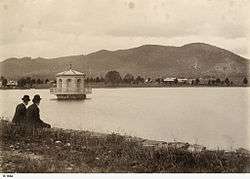Paradise, South Australia
| Paradise Adelaide, South Australia | |||||||||||||
|---|---|---|---|---|---|---|---|---|---|---|---|---|---|
 | |||||||||||||
| Population | 6,557 (2011 Census)[1] | ||||||||||||
| Established | 1850 | ||||||||||||
| Postcode(s) | 5075 | ||||||||||||
| LGA(s) | City of Campbelltown | ||||||||||||
| State electorate(s) | Morialta | ||||||||||||
| Federal Division(s) | Sturt | ||||||||||||
| |||||||||||||
Paradise is a northeastern suburb of Adelaide in South Australia. It is bounded on the north side by the River Torrens. Amongst its neighboring suburbs are Highbury, Dernancourt, Athelstone, Newton and Campbelltown.
Paradise is in the City of Campbelltown local government area. It was split across the South Australian House of Assembly electoral districts of Morialta (south-east part) and Hartley (north and west parts of Paradise) but has since all been incorporated into Morialta, and is in the Australian House of Representatives Division of Sturt.
History
Toponomy
The suburb, originally "Shepley", was named "Paradise" by Joseph Ind, who had an orange orchard on the banks of the nearby Torrens River, and was named for his "Paradise Bridge Hotel" after a property called Paradise near his native Tetbury. The Ind Orchards were so productive and of such quality that the area was claimed to "truly be a paradise" for fruit.
Establishment
The Ind family settled the area, and built three significant properties of which only one remains in its original form. The first being Balmoral House which was built from the "cellar up" with the original immigrant Joseph Ind moving his family over once the cellar was complete and the ground floor was being built. Balmoral Road was the original entrance to the property. The property is now a retirement village after Christopher Ind and his mother sold and moved to Sydney with the balance of the family. At the time of the sale the property was in completely unrestored and excellent condition, containing original furnishings from its early days. It featured original horse stables, a croquet lawn and rare trees which had been brought from around the world. The family names are still found in the street names in the area, namely Ind and Christopher.
Other members of the Ind family also come across from England in the mid-1800s and added two more homes of significance to the area. The first being the base building for the retirement home opposite the Paradise Hotel on Lower North East Rd. The final and currently still original Ind related residence can be found at Urban Avenue at Paradise. Its tessellated tile chimneys can been seen from Lower North East Road. There are many minor dwelling also found on Lower North East Road and in the vicinity of Balmoral House that were built as shearers quarters.
A post office was opened at Paradise on 1 June 1877.[2]
Geography

The topography of Paradise is mostly flat, with the river Torrens acting as the northern boundary.
The site was the location of many market gardens during the 20th century and some of these still remain, as can be seen by contemporary satellite imagery. Housing now occupies much of the suburb.
The suburb contains the Thorndon Park Reserve, formerly the site of Thorndon Park Reservoir, built in 1860 and the first reservoir in Adelaide's Metropolitan water supply. The reservoir was supplied by the River Torrens via an aqueduct.
Education
Paradise has an Early Learning Child Care Centre,[3] three Primary Schools and a High School.
The Paradise Primary School is a Reception to Year 7 school, which opened in 1978.[4]
Sunrise Christian School is a Reception to Year 7 school, which opened in 1989.[5]
The Campbelltown Primary School amalgamated with the Charles Campbell Secondary School in 2012[6] to form the Charles Campbell College.[7][8] The College has in excess of 1100 students, from Reception to Year 12, and is divided into three sub-schools: Junior School (Reception to Year 6), Middle School (Years 7-9) and Senior School (Years 10-12).[9]
Transport
Transport within Paradise consists mainly of two-way suburban streets. The main arterial roads going through the suburb include Gorge Road, Lower North East Road and Darley Road.
Public transport consists of a bus service run by Adelaide Metro. Routes include 174, 176, 178, 579, H20, and H30. The O-Bahn Busway has a major interchange within the suburb.
Notable people
Charles James Fox Campbell. grazier and early settler of Adelaide, South Australia, whose name is commemorated in the Adelaide suburb of Campbelltown, South Australia and the municipality, the City of Campbelltown, South Australia.
References
- ↑ Australian Bureau of Statistics (31 October 2012). "Paradise (State Suburb)". 2011 Census QuickStats. Retrieved 16 June 2015.
- ↑ Walker, Martin (2004) The Post, Telegraph and Telephone Offices of South Australia and the Northern Territory, p. 240. Torrensville, South Australia: published by the author, ISBN 0-9757019-0-8
- ↑ Paradise Early Learning Centre website, Retrieved 16 June 2015
- ↑ Website Paradise Primary School. Retrieved 16 June 2015.
- ↑ Website Sunrise Christian School, Paradise. Retrieved 16 June 2015.
- ↑ News Release New look College in the northeast opens its doors. Retrieved 16 June 2015.
- ↑ Website Charles Campbell College, retrieved 16 June 2015.
- ↑ NAPLAN Charles Campbell College, Paradise, SA. Retrieved 16 June 2015.
- ↑ School Context Statement Charles Campbell College. Retrieved 16 June 2015.
Coordinates: 34°52′19″S 138°40′34″E / 34.872°S 138.676°E